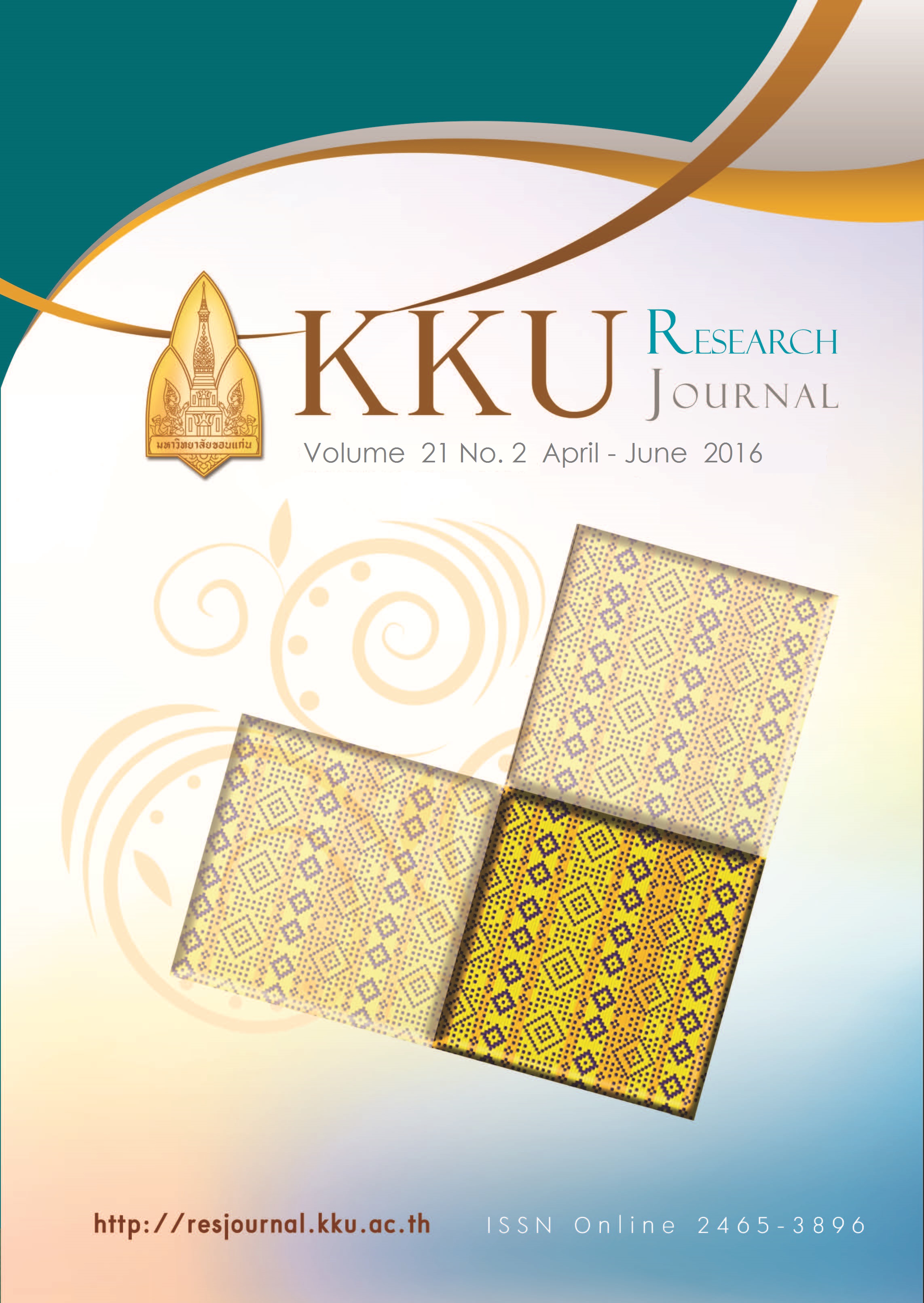Biohydrogen production by microalgae isolated from the rice paddle field in Thailand
Main Article Content
Abstract
Hydrogen produced by cyanobacteria and green algae is a very interesting energy carrier because it is produced by a photosynthetic pathway using sunlight as an energy source. In this study, 59 cyanobacterial and green algal strains were isolated from soil and water sources of rice paddle field in Thailand. Out of them, 9 cyanobacterial isolates and 9 green algal isolates were purified. Among them, unicellular cyanobacterial isolate AngS1 showed the highest H2 production rate. Its highest H2 production rate of 389.630±72.084 nmolH 2 mg chl-1 h-1 was found in cells grown in BG11 for 1 week followed by incubating cells in BG11 0 for 24 hours and adaptation under dark anaerobic condition for 2 hours. The optimal concentrations of glucose, MgSO4.7H2O and Fe3+ for H2 production rate were 0.189 mmolC L-1, 3 mM, and 20 μM, respectively. The highest H2 accumulation of 4,174.364±278.324 nmolH 2 mg chl-1 was obtained when incubating cells in the optimal medium for 11 days.
Article Details
References
[2] Reddy PM, Spiller H, Albrecht SL, Shanmugam KT. Photodissimilation of fructose to H2 and CO2 by a dinitrogen-fixing cyanobacterium, Anabaena variabilis. Appl Environ Microbiol. 1996 Apr;62(4):1220-6.
[3] Chen PC, Fan SH, Chiang CL, Lee CM. Effect of growth conditions on the hydrogen production with cyanobacterium Anabaena sp. strain CH3. Int J Hydrog Energy. 2008 Mar;33(5):1460-4.
[4] Ananyev G, Carrieri D, Dismukes GC. Optimization of metabolic capacity and flux through environmental cues to maximize hydrogen production by the cyanobacterium “Arthrospira maxima”. Appl Environ Microbiol. 2008 Oct;74(19):6102-13.
[5] Weissman JC, Benemann JR. Hydrogen production by nitrogen starved cultures of Anabaena cylindrica. Appl Env Microbiol. 1977 Jan;33(1):123-31.
[6] Serebryakova LT, Sheremetieva M, Tsygankov AA. Reversible hydrogenase activity of Gloeocapsa alpicola in continuous culture. FEMS Microbiol Lett. 1998 Sep 1;166(1):89-94.
[7] Serebryakova LT, Sheremetieva M, Lindblad P. Hydrogenase activity of the unicellular cyanobacterium Gloeocapsa alpicola CALU743 under conditions of nitrogen limitation. Microbiology 1999 68:249-53.
[8] Melis A, Zhang LP, Forestier M, Ghirardi ML, Seibert M. Sustained photobiological hydrogen gas production upon reversible inactivation of oxygen evolution in the green alga Chlamydomonas reinhardtii. Plant Physiol 2000 Jan;122(1):127-36.
[9] Troshina O, Serebryakova LT, Sheremetieva M, Lindblad P. Production of H2 by the unicellular cyanobacterium Gloeocapsa
alpicola CALU743 during fermentation. Int J Hydrog Energy. 2002 Nov;27(11): 1283-9.
[10] Antal TK, Lindblad P. Production of H2 by sulphur-deprived cells of the unicellular cyanobacteria Gloeocapsa alpicola and Synechocystis sp. PCC 6803 during dark incubation with methane or at various extracellular pH. J Appl Microbiol. 2005 Jan;98(1):114-20.
[11] Tsygankov AA, Kosourov SN, Tolstygina IV, Ghirardi ML, Seibert M. Hydrogen photoproduction by sulfur-deprived Chlamydomonas reinhardtii under photoautotrophic conditions. Int J Hydrogen Energy. 2006 Jun 24;3(11): 1574-84. [12] Taikhao S, Junyapoon S, Incharoensakdi A, Phunpruch S. Factors affecting biohydrogen
production by unicellular halotolerant cyanobacterium Aphanothece halophytica. J Appl Phycol. 2013 Apr;25(2):575-85. [13] Taikhao S, Incharoensakdi A, Phunpruch S. Dark fermentative hydrogen production by the
unicellular halotolerant cyanobacterium Aphanothece halophytica grown in seawater. J Appl Phycol. 2015 Feb;27(1): 187-96.
[14] Baebprasert W, Lindblad P, Incharoensakdi A. Response of H2production and Hox hydrogenase activity to external factors in the unicellular cyanobacterium Synechocystis sp. strain PCC 6803. Int J Hydrog
Energy. 2010 Jul;35(13):6611-6.
[15] Rashid N, Song W, Park J, Jin H-F, Lee K. Characteristics of hydrogen production by immobilized cyanobactrium Microcystis aeruginosa through cycles of photosynthesis and anaerobic incubation. J Ind Eng Chem. 2009 Jul 25;15(4):498-503.

